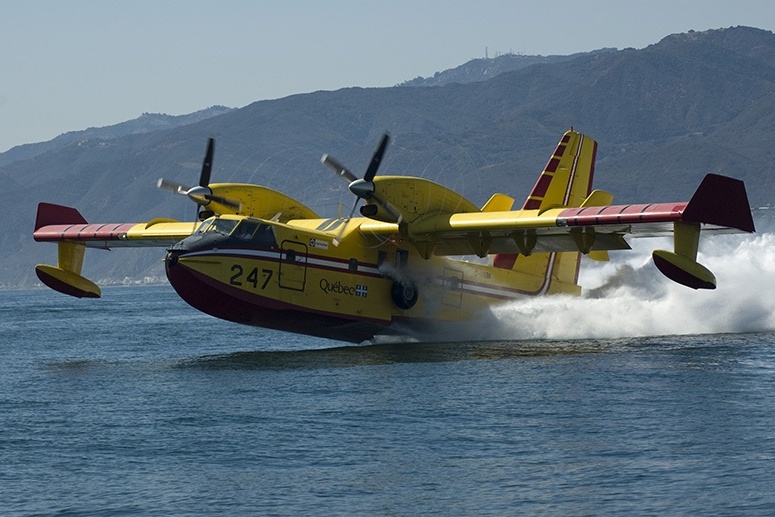The CL-215 lived with the consequences of the modest conditions of its birth. The five short series produced according to sales were always looking for manufacturing economies.
The effects were evident even in its dashboard, studded with analog dials.
“The dials were bought at the lowest price, where they were available, which meant that it was only in series of around ten planes that the dials were the same,” notes the former avionics engineer. Sylvain Morel, now retired, who served as chief avionics integrator on the aircraft in the mid-1990s.
“The communication systems were never the same from one series to the next. It was very difficult to do maintenance engineering on that. »

PHOTO FROM WIKIMEDIA COMMONS
The dashboard studded with analog dials of the CL-215
But these were, after all, only inconveniences.
The main problem was its piston engines.
Canadair has long sought a more modern mode of propulsion than the old R-2800 with 18 radial cylinders for its tanker aircraft. The appearance of a new generation of propeller turboprops for regional transport in the early 1980s provided an engine that was sufficiently light, reliable, powerful and fuel-efficient.
A first CL-215T (T for turboprop), equipped with two PW123 engines from Pratt & Whitney Canada, flew in 1989, more than 20 years after the maiden flight of the CL-215.
Canadair first offers its customers the option of installing turboprops on their existing CL-215s. The integration of the new engine, however, led to such a cascade of modifications that a new designation emerged: the CL-415.
“With so much power, we end up with aerodynamic problems,” describes Sylvain Morel. “You have so much propulsion power that it takes two gorillas to maneuver,” he caricatures.
To increase the stability of the aircraft, aerodynamic appendages are installed on the wingtips and tail. Hydraulic assistance is added to the flight controls to make them lighter.
“In the 215, the controls were not assisted,” emphasizes former pilot Gaston Audy. It takes strength to drive a 215. In a 415, everything is assisted. »
The CL-415 cabin is now air-conditioned. “It was hot in 215! », remembers the pilot.
Sylvain Morel participated in numerous flight tests aboard the robust but crude aircraft. “A horror,” he confirms about its aesthetics. “But he has charm!” You have to fly on board to see what an extraordinary plane it is. »
Electricity in the air
Due to the greater inertia of their turbines, more energy is required to launch turboprops. Powerful nickel-cadmium batteries replace the CL-215’s old lead-acid batteries.
It follows “inevitably an avionics change because all the needle instruments become obsolete”, relates Sylvain Morel.
The dashboard is completely redeveloped with electronic systems and digital screens. You no longer feel like you’re flying a World War II bomber.
“Ergonomically, big improvement! », notes the retired engineer.
The redesign of the device is also an opportunity to comply with a request from French customers, who want more flexibility in releasing water.
Rather than two tanks and two doors, the CL-415 has four tanks and four doors. They contain 6135 liters of water, or 15% more than the CL-215.
“The four doors open all at the same time, or two at a time on the left or right, or one at a time, or in sequence,” explains Sylvain Morel.
A new electronic release control system adjusts the sequence and timing of door openings to produce the optimal water dispersion based on altitude and fire characteristics.
The end… and what’s next
The CL-415 program was launched in October 1991 on the basis of an order for a dozen aircraft by France.
“It’s a machine that has evolved in certain aspects, but the basis of the 415 is the same as that of the 215,” observes retired maintenance technician Michel Blumhart. The fuselage has the same length and width. They are the same wings, except for the winglets [ailettes] at the tips of the wings. »
Some 95 CL-415s will be completed between 1993 and 2015.
Canadair was bought from General Dynamics by the Canadian government in 1976, then sold to Bombardier 10 years later. Facing serious liquidity problems, Bombardier Aerospace sold the water bomber program to the Alberta firm Viking in 2016.
In 48 years, Canadair and Bombardier Aerospace had assembled some 220 air tankers.

PHOTO N FAZOS, PROVIDED BY DE HAVILLAND CANADA
De Havilland Canada relaunched the water bomber program in 2022, under the name DHC-515.
The story is not over. De Havilland Canada, which holds the rights through Viking, announced in March 2022 that it was officially launching the program for its revamped – and perfectly recognizable – version, the DHC-515.
Maybe ugly, but timeless.
220 devices in 48 years
Number of CL-215s built (from 1967 to 1990): 125
Number of CL-415s built (from 1993 to 2015): 95

PHOTO WIKIMEDIA COMMONS
One of the two scoops of a CL-415.
The legend of the sucked swimmer
In the novel Barney’s Version (The world according to Barney) by Mordecai Richler, a mysterious disappearance is solved when we learn that the body of a swimmer was found among burned debris. He was apparently accidentally sucked up by a water bomber and dropped on the fire.
Could a swimmer or diver be swallowed by a CL-215 or CL-415?
“It’s totally impossible,” says retired engineer Sylvain Morel, who worked on the amphibious plane. “The scoops measure approximately 4 in. by 5 in. (10 cm by 12 cm). Additionally, there is a grid inside this opening to ensure that branches or debris do not enter the conduit. »
